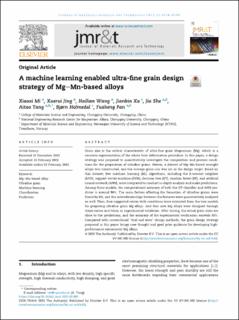| dc.description.abstract | Grain size is the critical characteristic of ultra-fine grain Magnesium (Mg), which is a concrete representation of the whole heat deformation procedure. In this paper, a design strategy was proposed to quantitatively investigate the composition and process conditions for the preparation of ultrafine grains. Herein, a dataset of Mg–Mn-based wrought alloys was constructed, and the average grain size was set as the design target. Based on this dataset, five machine learning (ML) algorithms, including the k-nearest neighbor (kNN), support vector machine (SVM), decision tree (DT), random forest (RF), and artificial neural network (ANN), were integrated to conduct in-depth analysis and make predictions. Among these models, the computational accuracy of both the DT classifier and ANN predictor is around 90%. The main factors affecting the formation of ultrafine grains were found by ML, and the interrelationships between the features were quantitatively analyzed as well. Then, four suggested routes with conditions were extracted from the tree models for preparing ultrafine grain Mg alloys. And four new Mg alloys were designed through these routes and taken as experimental validation. After testing, the actual grain sizes are close to the predictions, and the accuracy of the experimental verification exceeds 80%. Compared with conventional “trial and error” design methods, the grain design strategy proposed in this paper brings new thought and good prior guidance for developing high-performance commercial Mg alloys. | en_US |

